- Home
- Encyclopedia
- Ed Farlow, Tim McCoy and Their Native Friends O...
Ed Farlow, Tim McCoy and Their Native Friends on Stage and Screen
The old trapper galloped for his cabin, with 75 yelling Arapaho close behind. Reaching his front door just in time, he slammed it in his enemies' faces. His gun spat bullets from the windows, and warriors fell by the dozens until they retreated—all but one, who crept up close and threw a lighted torch at the cabin. Smoked out, the trapper emerged, was captured and tied to a stake. The Indians piled brush and straw around it, and the incident could have only one ending.
As tendrils of flame rose from the straw, women in the grandstand shrieked and fainted. Even the men blanched. Some audience members half-believed that the old white trapper had actually been killed.
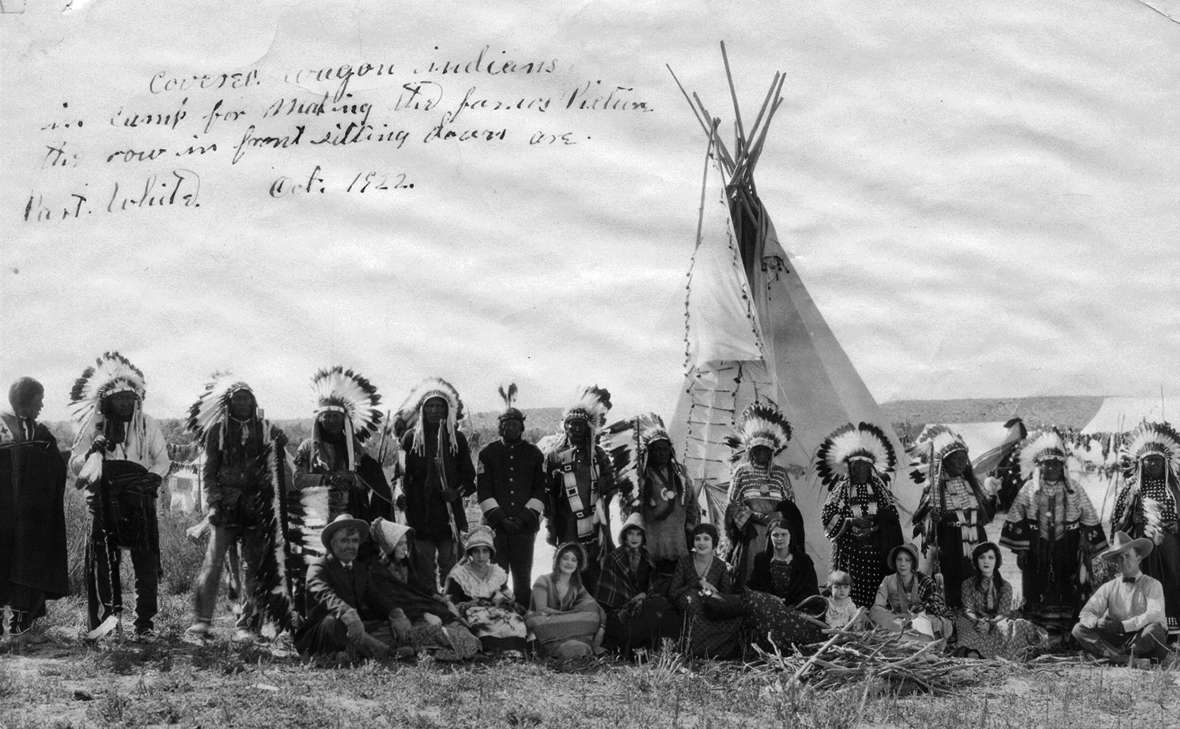
This Wild West show, the 14th annual event of its kind, and not to be confused with its contemporary, Buffalo Bill’s Wild West, was held in Lander, Wyo., in 1908. According to some who attended, it was so well staged that nobody could figure out that a dummy had been substituted to allow the trapper to escape. Not only that, the trapper wasn't even a bona fide white man: His name was Albert "Stub" Farlow, and his mother, Lizzie Lamoreaux Farlow, was one-half Hunkpapa Sioux, a niece of the ferocious warrior, Gall, military leader at the Battle of the Little Bighorn. Stub's father, Ed Farlow, was one of the producers of the show.
Stub's role in the show typified the public face of Native Americans and mixed-bloods as they adjusted to their post-defeat lives on reservations or mingled in white culture. As far back as 1883, William F. "Buffalo Bill" Cody had produced his first show, Buffalo Bill's Wild West, touring the U.S. and eventually Europe. The show featured Indians attacking a stagecoach, wagon train or settler's cabin. A make-believe buffalo hunt was also staged. Cody's shows, though sensational, were the first of what became some Native Americans’ new opportunities to get off the reservation and gain some relief from the monotony of that life.
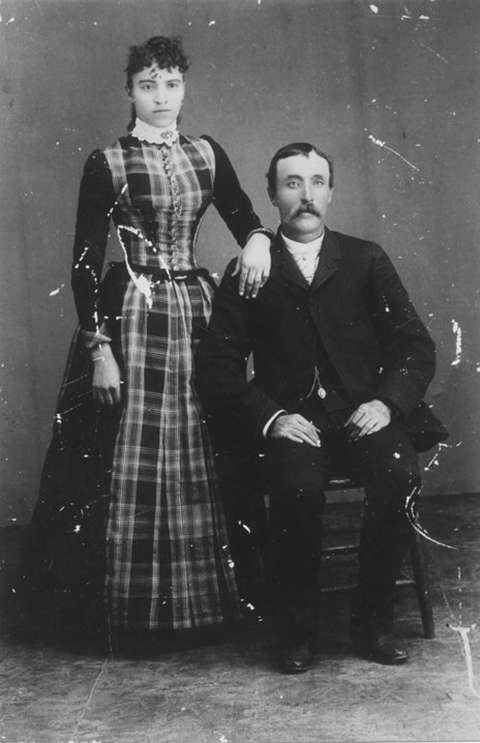
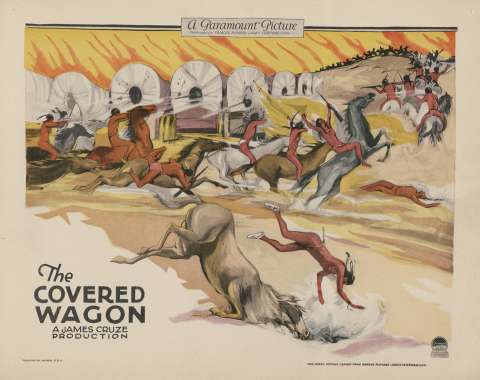
These opportunities continued during the 1920s in the early silent film era when Ed Farlow and Tim McCoy became theatrical agents for the Arapaho and Shoshone on Wyoming's Wind River Reservation, and also for members of the Bannock and Crow tribes of, respectively, Idaho and Montana. Both men were white Wyoming ranchers and, according to their own accounts at least, were trusted friends of the Indians.
Ed Farlow
Ed Farlow, born in Iowa in 1861, traveled to Wyoming at age 15, leaving home without the knowledge or consent of his father. In June 1876, two months after his arrival, Farlow was camping near the Bighorn River with a small group of prospectors when they noticed several parties of Indians close by. Farlow did not actually witness the Battle of the Little Bighorn, but heard about it immediately thereafter from some Indian friends of his companions.
Farlow settled in the Lander area and by 1883, was working for his father-in-law, rancher Jules Lamoreaux, who ran his cattle on the Wind River reservation. Through his work on and around the reservation, Farlow made friends among mixed-bloods and Indians and, surprisingly, in a dispute with a Shoshone man over a stolen horse that was resolved by Chief Washakie, became an accepted member of the Shoshone tribe. Over the years, Farlow also met and befriended Sioux and Arapaho.
In July 1913, Farlow traveled out of Wyoming with his Indian friends for the first of what was to be many promotional trips for various purposes. The Colorado Publicity League had invited him, along with 35 Arapaho, to the annual conclave of the Knights Templar in Denver. Farlow and the Indians, explained members of the Publicity League committee, were there to advertise the "Last Grand Council of the American Indians," a mammoth event slated for the following year.
Although Grand Council plans were eventually canceled because of the outbreak of World War I, while the Farlow party was in Denver the Indians held a Wolf Dance at their campground near the amphitheater set up for the Knights Templar festivities. The dance, which the Indians performed for their own amusement, attracted, according to Farlow’s account, a crowd of 40,000. The throng pressed so close that the encircling fence broke. Then Farlow and the Indians had to be escorted out by the police.
In 1914, Farlow traveled to Casper, Wyo., with 75 Indians for a three-day celebration, and then to Fort Collins, Colo., with 25 Indians in 1916. In Farlow’s account he does not say whether they were Arapaho or Shoshone. In subsequent years, he accompanied Indian groups to other Wyoming towns, including Rawlins, Riverton and Lander.
In September 1922, Farlow received a phone call from Tim McCoy, who had just resigned his post as adjutant general of the Wyoming National Guard to accept a position as technical advisor with Famous Players-Lasky, a Hollywood film company. McCoy had contracted to provide 500 Indian actors for the filming of The Covered Wagon, based on the novel by Emerson Hough. After some scrambling, because the actors had to have long hair and be able to ride bareback—an increasingly rare combination of traits—Farlow and McCoy found their 500. Some were Shoshone and Arapaho from the Wind River Reservation and others were Bannock from Fort Hall in northern Idaho.
The filming, in Milford, Utah, lasted about eight weeks. McCoy was allowed to hire up to three other men to supervise the Indians; presumably Farlow was one of these. McCoy later reported that this filming and his friendship with the Indians began his own movie career. And the movie itself was a huge success. It was Hollywood’s largest-grossing film up to that time, and held that record for 10 more years.
Tim McCoy
Tim McCoy was born of Irish Catholic parents in Saginaw, Mich., in 1891. In spring 1909, at age 18, he took a train to Omaha, Neb., without telling his parents that he had left St. Ignatius, the Jesuit college in Chicago. He had been studying Latin there, probably in preparation for the priesthood. McCoy ended up in Lander, Wyo. Like many other young men floating around the West in those days, he found work as a cowboy.
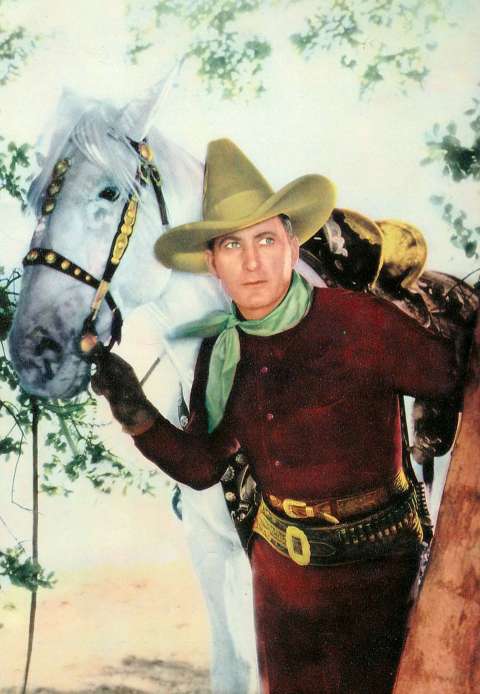
From the beginning, McCoy was interested in and curious about the Indians. Noticing that many white men were insolent and contemptuous to the Indians they encountered while riding the range, he took special pains to greet the Indians with respect. Although many of the younger Indians spoke English, McCoy wanted to talk with the older Indians as well. In this, though, he was thwarted by the double language barrier: He knew no Indian language and each tribe spoke in its own tongue. McCoy's Arapaho friend, Buffalo Lodge—whose white name was George Shakespear—taught him the sign language of the plains Indians. This enabled McCoy to communicate with members of different tribes.
Movies and live prologues
Both Farlow and McCoy claimed friendship with Arapaho warrior Goes-In-Lodge, who was about 79 when The Covered Wagon was filmed. Goes-In-Lodge, along with dozens of his tribe, played the stereotypical Indian roles reminiscent of Cody's shows in at least six movies, and appeared in most of the live prologues Famous Players-Lasky and other companies produced to promote their films. The first live prologue was staged at Grauman's Egyptian Theatre in Hollywood, Calif., in the spring of 1923. All the subsequent prologues for various other movies were roughly the same: Approximately 35 Indians, dressed in their own war bonnets, fringed buckskin shirts, beaded leggings and quilled moccasins, stood on stage with Tim McCoy. Each individual stepped forward in turn to tell his or her own story in sign language, with McCoy interpreting.
The contract for this first prologue ran four months, until early August 1923. However, no sooner was it concluded than Famous Players-Lasky re-engaged the Indians to travel to London. Both Farlow and McCoy went on this trip, which lasted more than six months, from Aug. 27, 1923, until March of the following year, and included appearances in New York City, Chicago and Paris. Concurrently, prologues continued in Hollywood with some of the Arapaho who had refused to travel to London over the unknown and dangerous Big Water. A white actor stood in for McCoy.
Through the mid to late 1920s, Farlow and McCoy continued as technical advisors for the filmmakers and as theatrical agents for the Indians. Farlow served as guide for more live prologues in Philadelphia, Boston and Hollywood, negotiating and managing the Indians' fees as well. Eventually he accompanied Indian groups on 27 trips coast-to-coast, including performances in San Francisco and Los Angeles, Salt Lake City, Omaha and many smaller cities and towns.
McCoy turned to acting; among his first films were War Paint (1926), The Winning of the Wilderness (1926) and Wyoming (1927). For these silent films plus Thundering Herd (1924), and Iron Horse (1925), he and Farlow engaged hundreds of Indian actors and extras, some of whom were Arapaho: Goes-in Lodge, Left Hand, Yellow Calf, Mr. and Mrs. Black Weasel, Buffalo Fat, Black Horse, Yellow Horse, Mr. and Mrs. Red Turtle, Mr. and Mrs. Red Pipe, Alberta Sitting Eagle, Red Fox, George Shakespear, Bill Shakespear, Jack Shavehead, Charlie White Bull, Rising Buffalo, Night Horse, William Penn, Painted Wolf, Charlie Whiteman and Little Ant.
Also mentioned were White Horse, a Cheyenne; Black Thunder, a Bannock; and two sons of Shoshone Chief Washakie, identified only as Dick and Charlie. McCoy noted that Iron Eyes Cody, whom he believed to be a Cherokee from Oklahoma, went on to become "perhaps the most knowledgeable and authentic of … modern Indian actors." (Much later, in 1971, Cody starred in a famous "Keep America Beautiful" anti-littering television commercial, in which he played an Indian paddling a canoe through polluted waters, and, when he turned toward the camera, weeping a large, solitary tear. In fact he was Espera Corti, known to his family as Oscar, born in 1902 in Louisiana to Sicilian immigrant parents, who, after a turbulent and poverty-stricken childhood, moved to Hollywood with his two brothers and began a long career in the movies under the name and tribal affiliations he had invented for himself.)
Working conditions
Through all their various engagements, the Indians were fairly paid and, according to both Farlow and McCoy, not exploited. For The Covered Wagon they earned per day, in addition to food and transportation: $5 per adult, 50 cents per child, $1 for each horse, and $1 per tipi. McCoy commented that this was "more than most of them saw in a year." McCoy's own wages for The Covered Wagon, at $50 per week, were comparable to those of the Indians.
For the London prologue, Farlow successfully negotiated all expenses plus $5 per day for each individual. McCoy's account names the figure at $8 per day. Regarding subsequent films, McCoy observed that, contrary to the "revisionist" claims of some, Indians were not paid less than white man extras and also enjoyed themselves while acting. The non-sensational nature of the live prologues plus fair wages, expenses paid for travel, housing and food plus their two reliable white intermediaries, apparently made it worth the Indians' while to continue participating, no matter how they were portrayed on screen.
The meeting of divergent cultures created some amusing episodes as, during their travels, the Indians encountered new environments and situations. While shopping at Macy's in New York City before embarking on their sea voyage to England, Red Turtle accidentally stepped onto a rising escalator. He was startled, but by calm signs, Farlow instructed him on how to get off, and then had to face the somewhat harder task of persuading Red Turtle's wife onto the escalator to join her husband at the top: "I had to take a firm hold of her arms and push her on."
After their continental trip, the Indians appeared at a press conference in New York City arranged by Players-Lasky. With McCoy interpreting as usual, the reporters asked the Indians what London was like.
"It was the same as Wind River," Goes-in-Lodge replied, his face impassive. Pressed for an explanation, he added, "The underground, the subway." Then, breaking into a grin, he explained to the puzzled reporters, "All same. Prairie dog go down one hole, come up another."
A few years later, while filming War Paint in the canyon mouth of Wyoming's Little Wind River, Indian actors had to stage a fight with rubber knives. This struck them as so absurd that they were laughing during the mock fight, and the director had to tell Farlow to make them be serious.
According to Farlow, the Indians who went on tour sent some of their pay home and established a "feast fund" so they could hold a feast for the whole tribe on their return. Farlow was also expected to contribute, and was probably invited to the celebration.
On several occasions when a scene or a whole movie was being shot in Wyoming and Ed Farlow could not be there as technical advisor and helper to the Indians, he sent his one-quarter Sioux son, Jule. Apparently the film companies sometimes hired Jule independently of his father as well, and at least once, Jule traveled to Hollywood as an Indian escort.
As for Jule's brother, Stub, his most sensational "Wild West" appearance was probably that 1908 show in Lander. He participated in so many other stunts, shows and rodeos—and won so many awards for the latter events—that Wyoming Secretary of State and former Lander dentist Lester C. Hunt, who later became governor and U.S. senator, considered Stub the "most typical cowboy" he'd ever known. For that reason, Hunt had Stub in mind when he commissioned the bucking horse design for Wyoming license plates. The logo is one of the best-known symbols of Wyoming, although few people may realize that the rider who inspired it was part Hunkpapa Sioux.
Goes-in-Lodge lived to be 88. He and McCoy saw each other for the last time in the spring of 1931. To the end of his life, Goes-in-Lodge was custodian of a 3-foot long briarwood pipe presented to the Arapaho by Cecil Baring, a wealthy Englishman, on their 1923 trip to London.
Tim McCoy ultimately acted in about 100 films and performed with the Ringling Brothers and Barnum and Bailey Circus from 1935-1937. On April 4, 1938, emulating Buffalo Bill Cody, his lifelong hero, he opened Tim McCoy's Wild West and Rough Riders of the World in Chicago. McCoy’s efforts proved much less long lasting. The show closed just 21 days later in Washington, D.C. McCoy lost about $300,000 on the venture.
Ed and Lizzie Farlow helped start the Lander Pioneers group in 1886. Farlow was mayor of Lander from 1923-1927 and also served on the school board, as justice of the peace and in the Wyoming Legislature from 1932-1934. On June 21, 1931, in a special ceremony, the Arapaho made him an official member of their tribe, though he had been informally a member for more than 50 years. He continued as a friend and advocate of Indians from many tribes, helping them find work, protesting when they were mistreated and feeding more Indians at his home, ranch and camps than did any other white man in Fremont County.
Nonetheless, all was not clear sailing with the Indians for Farlow and McCoy. At one point during the London trip, some sort of trouble arose—not well described by either man—and all Farlow could get out of the Indians was that "McCoy did not know how to handle Indians." Farlow himself mentioned that in his contact with the Indians he had "several close calls," adding that, notwithstanding his trusted role with the Indians, they hated white men in general and "when they are drunk it comes out." His wife Lizzie even commented, "they will kill you yet."
Any conquered people, watching attempts to stereotype if not obliterate their culture, must have mixed feelings toward even the most benevolent, helpful and sincere of their conquerors. It’s remarkable, therefore, that the friendships of both these white men, Ed Farlow and Tim McCoy, and their many Native American neighbors lasted as long and as well as they did.
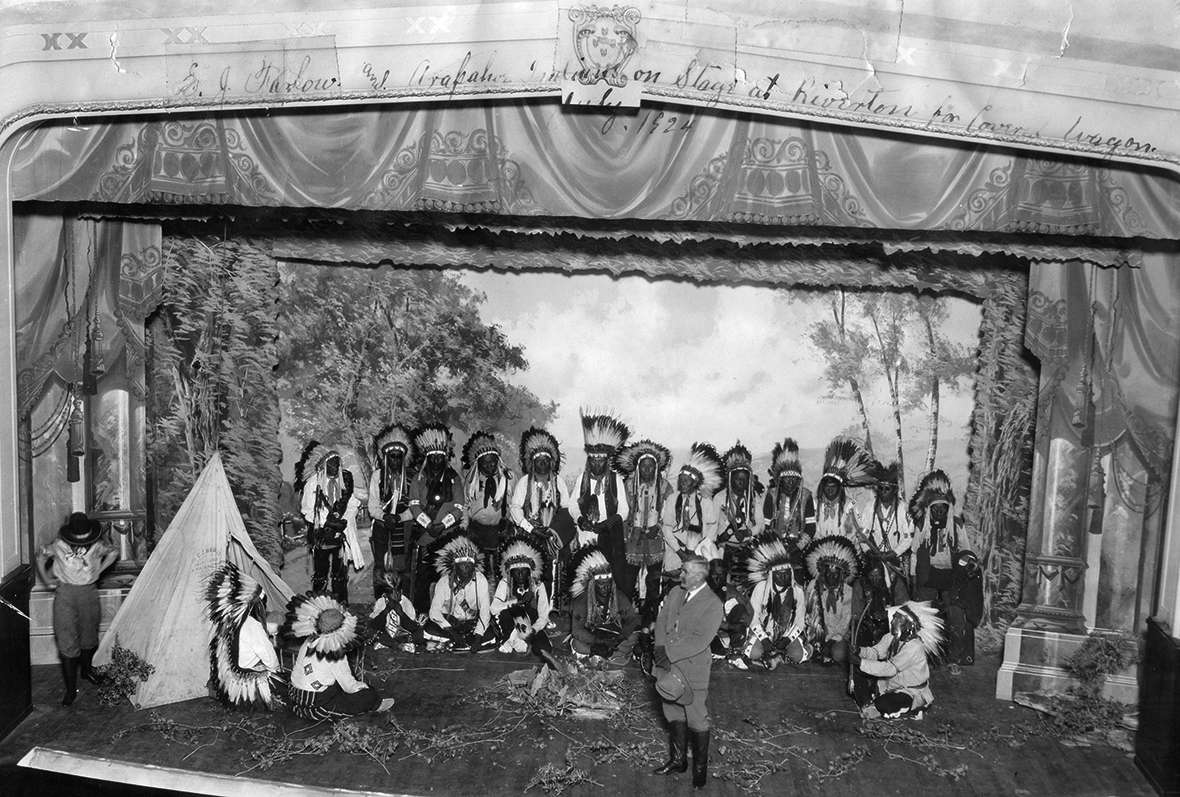
Resources
Primary Sources
- Farlow, Albert "Stub." “Surprise.” Undated manuscript. Intertribal Cultural Center, Central Wyoming College, Riverton, Wyo.
- Farlow, Edward J. Wind River Adventures: My Life in Frontier Wyoming. Researched, edited and annotated by Loren Jost. Glendo, Wyo.: High Plains Press, 1998, 32-33, 169-176, 182-209, 213-227, 230-234, 248-253.
- McCoy, Tim, with Ronald McCoy. Tim McCoy Remembers the West: An Autobiography. 1977. Reprint, Lincoln, Neb.: University of Nebraska Press, 1988, xvii, 1-20, 159-199, 242-251, 265-267.
- Wyoming State Journal, Lander. "Ed. J. Farlow, Wyoming Pioneer, Dies." April 10, 1951. Fremont County Pioneer Museum, Lander, Wyo.
Secondary Sources
- Aleiss, Angela. Making the White Man's Indian: Native Americans and Hollywood Movies. Westport, Conn.: Praeger Publishers, 2005, 32.
- ____________. "Native Son." New Orleans Times-Picayune, May 26, 1996. Accessed June 2, 2016, at http://www.mail-archive.com/nativenews@mlists.net/msg01286.html.
- Bonner, Robert E. "Town Founder and Irrigation Tycoon: The Buffalo Bill Nobody Knows." Accessed Nov. 17, 2015, at /essays/town-founder-and-irrigation-tycoon-buffalo-bill.
- Buscombe, Edward. 'Injuns': Native Americans in the Movies. Bodmin, Cornwall, U.K.: Reaktion Books Ltd., 2006.
- Gaddy, Jean C. "Wyoming's Insignia—The Bucking Horse." Annals of Wyoming, 26 no. 2 (July 1954): 129-136.
- Hilger, Michael. Native Americans in the Movies: Portrayals from Silent Films to the Present. Lanham, Md.: Rowman & Littlefield, 2016.
- Mikkelson, Barbara. "Iron Eyes Cody: Was Iron Eyes Cody a Native American?" Snopes.com. Accessed June 2, 2016 at http://www.snopes.com/movies/actors/ironeyes.asp.
- Rea, Tom. "Buffalo Bill and the Pony Express: Fame, Truth and Inventing the West." Accessed Nov. 17, 2015, at /essays/buffalo-bill-and-pony-express-fame-truth-and-inventing-west.
- Rollins, Peter C. and John E. O'Connor. Hollywood's Indian: The Portrayal of the Native American in Film. Lexington, Ky.: The University Press of Kentucky, 1998.
For Further Reading and Research
- Cary, Diana Serra. “ Baby Peggy and Indian Chiefs in Hollywood: Child Star Greets Arapahos of Covered Wagon Fame." American West 22, (January/February 1985): 49-50.
- Mamot, Ron. "Tim McCoy Remembers'The People.'" Wind River Rendezvous, March/April 1978, Issue 2, entire issue.
Illustrations
- The lobby card from The Covered Wagon is from Lobby Cards. Used with thanks.
- The color photo of Tim McCoy is from Wikipedia. Used with thanks.
- All other photos are from the collections of the Lander Pioneer Museum, used with permission and special thanks to Randy Wise of the museum staff.
